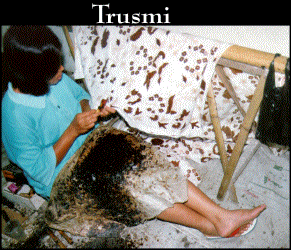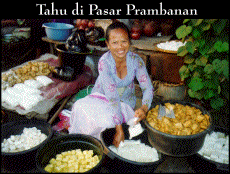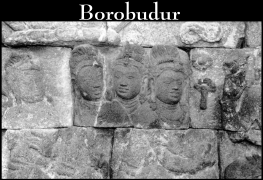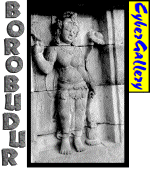
In the Indonesian cities we visited, everyone except the elderly women seemed to have partially or wholly adopted western clothing styles as their own. There was one exception, the selendang. The selendang is a long scarf, designed with the batik process, and used to carry everything under the sun from babies to baskets of food. Although it is a woman's article of clothing, we did see a man carrying his baby with one.
The most exceptional characteristic of traditional Javanese fashion is batik. Batik refers to a process, but has grown in usage to commonly refer to cloth that has been decorated by the process. Simply put, the batik process involves the application of hot wax with a canting (a small copper container, at the end of a thick, stubby reed handle, that has a small hole at one end through which hot wax can flow onto cloth) or a canting cap (a metal stamp). Traditionally, batik processing was performed by village households. After the mid-Nineteenth Century when Dutch tax policies forced the Indonesian populace to enter the cash economy, batik processing was increasingly performed by individuals who subcontracted work from a retailer or worked in a factory. The  performed on the village and household level.
performed on the village and household level.
The actual complexity of the process can be understood merely by looking at a section of fabric and realizing that colors are applied to areas where there has been no wax applied. Each color represents the application of wax, dying, and removal of that wax. As it can be imagined, this may take some time, but estimates of how long are exaggerated in the minds of foreigners who may think of a pace of work which is undoubtedly far faster than the pace with which we saw women working in these shops and factories. Since we were customers, the processing would often times only begin as we walked into a house, or shop area where processing was usually done. It's not that our visits were timed at unusual times, although they may have been by Indonesian standards, rather it seemed that the pace of production was relaxed. At times I would feel embarrassed that I caused someone to have to begin work with the simple question, "can I see the process?"
Markets and shops are packed with batik cloth and the prices, though negotiable, seem far to high for most Indonesians. When I asked one woman about this, she explained that the older women I see wearing batik sarongs are probably wearing cap (batik made with the stamp which itself is laborious, though comparatively less laborious than canting). Quality varies based on such considerations as the clothe, silk or cotton, its size, and its intricacy of the design; the number of colors used in the overall design; and whether or not the design has been applied to both sides.
In Solo, we learned that there is significance attached to least two traditional motifs which originate there: the lereng motif used to bring happiness, and the parang motif which is used for good fortune.
Traditionally, specific locales were known for specific colors. The batik we saw in Yogyakarta and Solo was overwhelmingly a shade of brown and black. Colors have significance associated with them too: blue is a symbol of water and the ocean, it symbolizes patience; black is the color for the ground, it symbolizes living; brown is the color for fire, it symbolizes desire; white is the color of the sky, it symbolizes freedom; and light brown, or modern yellow, are the colors of plants, they symbolize everything we are responsible for nurturing in this world.


The hygiene involved with cooking foods is rarely as strictly controlled, as it is in America where our government goes to great lengths to protect us from the unimaginable, As a result of having been lulled into complacency by this and our desire to eat after rigorous explorations, we usually forego scrutinizing the conditions under which our meat is killed and cooked. Besides, sometimes more attention to details such as these would make adapting to differences nearly impossible. |

After taking a pre-dawn bus ride from Yogyakarta to Borobudur, we ate at a small, covered eating area in the bus station. Our breakfast of nasi goreng (fried rice) and mie goreng (fried noodles) was so good we decided to return to the same stall later for lunch. This second time, Karen ordered mie goreng again and I thought I would try something else new so I ordered gado-gado, which was a cold vegetable salad with some cut up hard-boiled egg. It too was a very good dish until I had almost finished the meal when one particular spoon-full of food uncovered a large cockroach, but only after my stomach was nearly full and Karen had had a few bites herself.

When visiting Indonesia, there are two places above all that everyone has some image of before they actually see them: Bali and Borobudur. It is because of Western man's interest in these two places, perhaps above all else in Indonesia, that they have changed the most in this last century. One, arguably, for the worse, and the other, unquestionably, for the better. Further along we will discuss Bali, but for now, let's touch upon that place that was consciously hidden because it represented an age and religion that had been replaced centuries earlier by other religious dynasties.
 Southeast Asia has three dominant religions, Islam, Buddhism, and Catholicism: Buddhism is the dominant religion on the mainland of Southeast Asia, with the major exception of Peninsular Malaysia; Islam is the dominant religion in Insular Southeast Asia with the exception of the third dominant religion in the region; and that third religion, Catholicism, reigns all but supreme in the Philippines (again the exception is the southern islands of that archipelago where Islam dominates). Because Islam is so omnipresent on Java, it is a surprise to find Borobudur, one of the greatest monuments to Buddhism that exists, there.
Southeast Asia has three dominant religions, Islam, Buddhism, and Catholicism: Buddhism is the dominant religion on the mainland of Southeast Asia, with the major exception of Peninsular Malaysia; Islam is the dominant religion in Insular Southeast Asia with the exception of the third dominant religion in the region; and that third religion, Catholicism, reigns all but supreme in the Philippines (again the exception is the southern islands of that archipelago where Islam dominates). Because Islam is so omnipresent on Java, it is a surprise to find Borobudur, one of the greatest monuments to Buddhism that exists, there.
Borobudur, which has been described as a three-dimensional mandala, was constructed sometime during the 8th and 9th Centuries under the Buddhist, Sailendra Dynasty. As historical events unfolded, it was abandoned and all but forgotten until it was revealed to the colonial rulers during Stamford Raffles interregnum of rule in Indonesia during the early part of the 19th Century. Excavation commenced during this period and a full restoration project was carried out two centuries later, between 1973 and 1984. Little else is presently known about the site.
Borobudur, like nearby Prambanan, is a wonderful place to visit because it is one of those few ancient monuments that rests in its natural setting. It's an honor to walk through such a three-dimensional, open air museum, but you find yourself wondering if the centuries of obscurity might have been better off left undisturbed because the throngs of visitors will no doubt hasten its continued decay.
Because my understanding of that monument is so limited, the best I have to offer here are a few photographs that I hope will give you a bit of an understanding of the beauty which can be found there, even in its broken, worn, and decaying state. In the end, it is truly a monument to a civilization that has long since vanished.


